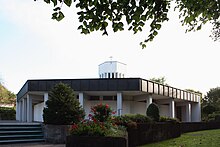St. Antonius (Hauptwil)
The St. Antonius Church is the Roman Catholic church of Hauptwil , a part of the municipality of Hauptwil-Gottshaus in the canton of Thurgau . Hauptwil belongs to the pastoral area Bischofsberg , which is made up of the parishes of Bischofszell-Hauptwil, St. Pelagiberg and Sitterdorf.
Development and construction history
The reason for the construction of a Catholic church in Hauptwil were Catholic Polish and French soldiers who were interned in Hauptwil during the Second World War and were not allowed to leave the place. Therefore, their field preachers held services on site, which aroused the need for their own Catholic services among the Catholics of Hauptwil. Initially, these services took place in private rooms and later on the ground floor of the Untere Schlössli . When more Catholics moved to Hauptwil after the Second World War, the number of people attending church services steadily increased. When the church of St. Pelagius in Bischofszell was being renovated, the Catholics of Hauptwil founded a chapel congregation with the aim of building a chapel in Hauptwil at the same time as the church in Bischofszell was being renovated. Franz Bucher, the architect who led the renovation of the church in Bischofszell, then drafted the plans for the construction of the St. Antonius church. In 1964, the Catholic chapel community acquired the building land for the St. Antonius Church in the Rondellen district in the middle of the village. On September 24, 1967, the building site was sanctified and the first groundbreaking was dug. The foundation stone was laid on December 10, 1967. The following year the building was completed, so that it could be consecrated on October 27, 1968, Christ the King's Day .
Building description
Church tower and exterior
Somewhat hidden and yet in the middle of the village is the St. Antonius Church in the Rondellen district next to a stream and adjacent to the area of a free church . Two paths lead from the little street to the two doors of the church, one of which is wheelchair accessible. A covered forecourt connects the two doors to the church. The roof of the polygonal church building is staggered. The choir is located under the highest roof element , and the bell chamber rises above it.
Bells
The church has a three-part bell. The two lower bells come from the old bells of the St. Pelagius Church in Bischofszell. They were cast by Carl Rosenlächer in 1858. The smallest bell was made by Emil Eschmann in Rickenbach TG in 1967 . The three bells were consecrated on May 26, 1968, and the next day the school children lifted them into the tower.
Interior and artistic equipment
The polygonal interior contains benches that are grouped in a semicircle around the sanctuary, which takes up the requirements of the liturgy constitution of the Second Vatican Council . In order to create an almost equal view of the altar for all churchgoers , the benches with 120 seats were installed on a sloping floor. The altar rests on three feet, which with their number refer to the Trinity . Three window slits per side also lead the daylight into the interior of the church. The crosses of the apostles take up the threefold by placing them in four groups of three candles on the side walls. The tabernacle is triangular and has a red enamel disc on the face on which a bronze lamb of God is attached. Above it is in a circle, the symbol of God, the Eternal Light . A wooden figure of the church patron, St. Anthony and a statue of Our Lady complete the interior of the church.
organ
After an electronium and later an organ positive had been used, the community decided to buy a small pipe organ. This was set up in the church in 1996. It is a positive from the company Gebrüder Späth , Rapperswil , which has been supplemented with a pedal mechanism that is installed in a separate housing. When the front doors of the positive are open, a two-legged pipe prospect becomes visible.
|
|
||||||||||||||||
- The registers are divided at c 1 / c sharp 1 .
- Pedal coupler
- Grinding windchest
- mechanical action mechanism
- mechanical stop action
literature
- Angelus Hux, Alexander Troehler: KlangRäume. Churches and organs in Thurgau. Huber, Frauenfeld 2007, pp. 224–225.
Web links
Individual evidence
- ↑ Angelus Hux, Alexander Troehler: KlangRäume. Churches and organs in Thurgau. P. 224.
- ^ Antonius Church Hauptwil. On the website of the pastoral area Bischofsberg, accessed on November 22, 2019
- ↑ Angelus Hux, Alexander Troehler: KlangRäume. Churches and organs in Thurgau. Pp. 224-225.
- ↑ Angelus Hux, Alexander Troehler: KlangRäume. Churches and organs in Thurgau. P. 225.
Coordinates: 47 ° 28 '42.78 " N , 9 ° 15' 10.37" E ; CH1903: 736 743 / 260 223


